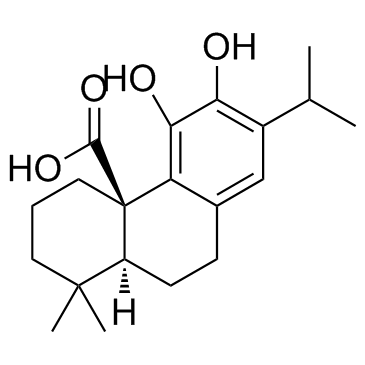Carnosic acid

Carnosic acid structure
|
Common Name | Carnosic acid | ||
|---|---|---|---|---|
| CAS Number | 3650-09-7 | Molecular Weight | 332.434 | |
| Density | 1.2±0.1 g/cm3 | Boiling Point | 506.4±50.0 °C at 760 mmHg | |
| Molecular Formula | C20H28O4 | Melting Point | 190 °C | |
| MSDS | Chinese USA | Flash Point | 274.2±26.6 °C | |
|
Redox-dependent induction of antioxidant defenses by phenolic diterpenes confers stress tolerance in normal human skin fibroblasts: Insights on replicative senescence.
Free Radic. Biol. Med. 83 , 262-72, (2015) Mild stress-induced hormesis represents a promising strategy for targeting the age-related accumulation of molecular damage and, therefore, for preventing diseases and achieving healthy aging. Fruits, vegetables, and spices contain a wide variety of hormetic ... |
|
|
Carnosol Is a Potent Lung Protective Agent: Experimental Study on Mice.
Transplant. Proc. 47 , 1657-61, (2015) Oxidative stress has been implicated in various disease states and ischemia/reperfusion injury is a direct consequence of oxidative stress in lung transplantation. Because the success rate of organ transplantation in which ischemia/reperfusion is inevitable i... |
|
|
Enhanced Eryptosis Following Exposure to Carnosic Acid.
Cell Physiol. Biochem. 37 , 1779-91, (2015) The phenolic abietane diterpene component of rosemary and sage, carnosic acid, may either induce or inhibit apoptosis of nucleated cells. The mechanisms involved in the effects of carnosic acid include altered mitochondrial function and gene expression. Human... |
|
|
A bioguided identification of the active compounds that contribute to the antiproliferative/cytotoxic effects of rosemary extract on colon cancer cells.
Food Chem. Toxicol. 80 , 215-22, (2015) Rosemary extracts have exhibited potential cytostatic or cytotoxic effects in several cancer cell models but their bioactive compounds are yet to be discovered. In this work, the anticancer activity of a rosemary-leaf extract and its fractions were assayed to... |
|
|
Using sheath-liquid reagents for capillary electrophoresis-mass spectrometry: application to the analysis of phenolic plant extracts.
Electrophoresis 36(2) , 348-54, (2015) The combination of CE and MS is now a widely used tool that can provide a combination of high resolution separations with detailed structural information. Recently, we highlighted the benefits of an approach to add further functionality to this well-establish... |
|
|
A rosemary extract rich in carnosic acid selectively modulates caecum microbiota and inhibits β-glucosidase activity, altering fiber and short chain fatty acids fecal excretion in lean and obese female rats.
PLoS ONE 9(4) , e94687, (2014) Carnosic acid (CA) and rosemary extracts (RE) show body-weight, energy metabolism and inflammation regulatory properties in animal models but the mechanisms are not yet understood. Gut microbiota plays an important role in the host metabolism and inflammatory... |
|
|
Citral derived amides as potent bacterial NorA efflux pump inhibitors.
Bioorg. Med. Chem. 16 , 6535-43, (2008) Monoterpene citral and citronellal have been used as starting material for the preparation of 5,9-dimethyl-deca-2,4,8-trienoic acid amides and 9-formyl-5-methyl-deca-2,4,8-trienoic acid amides. The amides on bioevaluation as efflux pump inhibitors (EPIs) agai... |
|
|
Piperine analogs as potent Staphylococcus aureus NorA efflux pump inhibitors.
Bioorg. Med. Chem. 16 , 9847-9857, (2008) Based on our recent findings that piperine is a potent Staphylococcus aureus NorA efflux pump inhibitor (EPI), 38 piperine analogs were synthesized and bioevaluated for their EPI activity. Twenty-five of them were found active with potentiating activity equiv... |
|
|
Carnosic acid prevents 6-hydroxydopamine-induced cell death in SH-SY5Y cells via mediation of glutathione synthesis.
Chem. Res. Toxicol. 25 , 1893-1901, (2012) Understanding the neuroprotective effects of the rosemary phenolic diterpene carnosic acid (CA) has attracted increasing attention. We explored the mechanism by which CA modulates the neurotoxic effects of 6-hydroxydopamine (6-OHDA) in SH-SY5Y cells. Cells we... |
|
|
Expression of microRNA-15b and the glycosyltransferase GCNT3 correlates with antitumor efficacy of Rosemary diterpenes in colon and pancreatic cancer.
PLoS ONE 9(6) , e98556, (2014) Colorectal and pancreatic cancers remain important contributors to cancer mortality burden and, therefore, new therapeutic approaches are urgently needed. Rosemary (Rosmarinus officinalis L.) extracts and its components have been reported as natural potent an... |